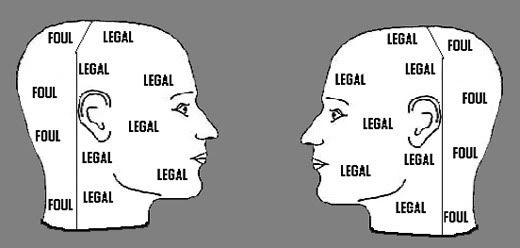Unified Rules Revised by ABC
On Thursday the Association of Boxing Commission passed a revised edition of the unified rules of mixed martial arts at the annual ABC conference.
The unified rules, which originally came to be in 2001, called for a restructure of weight classes as well as more thoroughly defined present rules.
One hot spot for debate in regards to rules is what defines the back of the head. Some have stated that it is the center of the back of the head – something commonly referred to as the “Mohawk”. Others have instead said that if you were wearing a pair of headphones, the entire area behind the ears would count.
The revised rule set defines the back of the head in accordance with the “Mohawk” definition.
As far as weight classes, things have been changed significantly. Major changes include adjusting the light heavyweight division to 205-225 and the heavyweight division to 225-265. The weight classes begin at 105 pounds and move in ten-pound increments up until 265 pounds. In total ten female weight divisions and fourteen male weight divisions were defined.
Another inclusion regarding women’s MMA were rules for amateur female competition. The revised unified rules call for three three-minute rounds with ninety-second rest periods between rounds.
A common occurrence in mixed martial arts when two fighters are on the ground is the top fighter placing his hand over his opponent’s mouth and nose to disrupt his breathing. The revised unified rules now deem this an illegal foul, with the only exception being choke attempts and the like where an arm may end up in that position.
Another confusing rule that was taken care of had to do with downward elbow strikes – specifically the “12 o-clock to 6 o-clock” (ceiling to floor) use of the elbows. It was stated that the original purpose of the rule was to prevent dangerous elbow strikes to areas such as the spine. Now the rule has been thrown out, leaving the only illegal elbow strikes as blows to illegal target zones (such as the back of the head or the throat).
Promotions do not need to change their weight divisions if they do not wish, nor do athletic commissions need to adopt the rule changes. The revised unified rules may also be altered by athletic commissions at their own discretion.
Unified Rules Revised by ABC
Forum rules
- Keithlewis
- CAGESLAYER

- Posts: 10586
- Joined: Fri Sep 07, 2007 6:49 pm
- Location: At the No Name Bar playing Golden Tee [phpBB Debug] PHP Warning: in file [ROOT]/vendor/twig/twig/lib/Twig/Extension/Core.php on line 1236: count(): Parameter must be an array or an object that implements Countable
- Keithlewis
- CAGESLAYER

- Posts: 10586
- Joined: Fri Sep 07, 2007 6:49 pm
- Location: At the No Name Bar playing Golden Tee [phpBB Debug] PHP Warning: in file [ROOT]/vendor/twig/twig/lib/Twig/Extension/Core.php on line 1236: count(): Parameter must be an array or an object that implements Countable
- NWOWolfpack
- FORUM ADMIN

- Posts: 8169
- Joined: Wed Sep 12, 2007 9:32 am
- Location: USA
- Contact:
From the CSAC and MMAWeekly:

The statement did clearly define how California will deal with the new rules, but they also pointed out the importance of their Rule 533 which states:
“Recognizing that different forms of martial arts exist, notwithstanding any rule in this division to the contrary, the commission may, in its discretion, authorize alternate rules or provisions from time to time for full contact martial arts championships and exhibitions so long as the safety and welfare of the contestants and the public are not jeopardized.”
Essentially, the state can authorize alternate rules as long as health and safety concerns are not compromised.
Regarding the ruling for what defines the “back of the head” when dealing with illegal strikes, the California State Athletic Commission has released a diagram of what they will use when defining and illegal strike.
“The back of the head is from one ear to the back of the other ear and as outlined in the diagram above. Only the referee can determine if a blow was legal or a foul and if a foul, if it was accidental or intentional. Intentional fouls that cause injury require a mandatory two-point deduction. Intentional fouls that do not cause injury require a mandatory one-point deduction. In determining point deductions for intentional fouls the referee may consult with the ringside physician.”
The state of California has also stricken the ABC’s ruling to allow elbow strikes defined as “12 to 6’oclock” or elbows that are thrown in a straight downward motion from a fighter above his head down onto his opponent. This move will still be considered illegal in California.
The “smothering” rule, which was outlined by the ABC in their most recent meeting to disallow a fighter from covering the mouth of an opponent with hands, forearms or by other means, will also be enacted in California and is considered “an unsportsmanlike trick or action and is therefore prohibited under the rule.”
One major change the state of California is not on board with is the ruling of newly created weight classes. The commission defines the weight classes in MMA as the following and also said it strongly recommend the ABC seek out the guidance of medical professionals to best determine weight differential guidelines.
Rule 510. Weights and Classes.
MALES
Flyweight: through 125 lbs. - No more than 3 pound difference
Bantamweight: 125.1-135 lbs. - No more than 5 pound difference
Featherweight: 135.1-145 lbs. - No more than 6 pound difference
Lightweight: 145.1-155 lbs. - No more than 7 pound difference
Welterweight: 155.1-170 lbs. - No more than 8 pound difference
Middleweight: 170.1-185 lbs. - No more than 8 pound difference
Light Heavyweight: 185.1-205 lbs. - No more than 12 pound difference
Heavyweight: 205.1-265 lbs. - No more than 20 pound difference
Super Heavyweight: 265.1 lbs. and over - No limit
FEMALES
Lightweight: through 125 lbs. - No more than 3 pound difference
Middleweight: 125.1-135 lbs. - No more than 5 pound difference
Light-Heavyweight: 135.1-150 lbs. - No more than 6 pound difference
Heavyweight: 150.1-175 lbs. - No more than 12 pound difference
Super Heavyweight: 175.1 lbs. and over - No more than 15 pound difference
It was also stated that the weight differences listed are a guideline and not a rule as to who will be allowed to fight by the commission.

The statement did clearly define how California will deal with the new rules, but they also pointed out the importance of their Rule 533 which states:
“Recognizing that different forms of martial arts exist, notwithstanding any rule in this division to the contrary, the commission may, in its discretion, authorize alternate rules or provisions from time to time for full contact martial arts championships and exhibitions so long as the safety and welfare of the contestants and the public are not jeopardized.”
Essentially, the state can authorize alternate rules as long as health and safety concerns are not compromised.
Regarding the ruling for what defines the “back of the head” when dealing with illegal strikes, the California State Athletic Commission has released a diagram of what they will use when defining and illegal strike.
“The back of the head is from one ear to the back of the other ear and as outlined in the diagram above. Only the referee can determine if a blow was legal or a foul and if a foul, if it was accidental or intentional. Intentional fouls that cause injury require a mandatory two-point deduction. Intentional fouls that do not cause injury require a mandatory one-point deduction. In determining point deductions for intentional fouls the referee may consult with the ringside physician.”
The state of California has also stricken the ABC’s ruling to allow elbow strikes defined as “12 to 6’oclock” or elbows that are thrown in a straight downward motion from a fighter above his head down onto his opponent. This move will still be considered illegal in California.
The “smothering” rule, which was outlined by the ABC in their most recent meeting to disallow a fighter from covering the mouth of an opponent with hands, forearms or by other means, will also be enacted in California and is considered “an unsportsmanlike trick or action and is therefore prohibited under the rule.”
One major change the state of California is not on board with is the ruling of newly created weight classes. The commission defines the weight classes in MMA as the following and also said it strongly recommend the ABC seek out the guidance of medical professionals to best determine weight differential guidelines.
Rule 510. Weights and Classes.
MALES
Flyweight: through 125 lbs. - No more than 3 pound difference
Bantamweight: 125.1-135 lbs. - No more than 5 pound difference
Featherweight: 135.1-145 lbs. - No more than 6 pound difference
Lightweight: 145.1-155 lbs. - No more than 7 pound difference
Welterweight: 155.1-170 lbs. - No more than 8 pound difference
Middleweight: 170.1-185 lbs. - No more than 8 pound difference
Light Heavyweight: 185.1-205 lbs. - No more than 12 pound difference
Heavyweight: 205.1-265 lbs. - No more than 20 pound difference
Super Heavyweight: 265.1 lbs. and over - No limit
FEMALES
Lightweight: through 125 lbs. - No more than 3 pound difference
Middleweight: 125.1-135 lbs. - No more than 5 pound difference
Light-Heavyweight: 135.1-150 lbs. - No more than 6 pound difference
Heavyweight: 150.1-175 lbs. - No more than 12 pound difference
Super Heavyweight: 175.1 lbs. and over - No more than 15 pound difference
It was also stated that the weight differences listed are a guideline and not a rule as to who will be allowed to fight by the commission.
What do you expect? The comedian is dead.


Return to “Mixed Martial Arts News and Discussion”
Who is online
Users browsing this forum: No registered users and 6 guests



